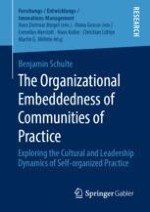2021 | OriginalPaper | Buchkapitel
3. Theoretical Background
verfasst von : Benjamin Schulte
Erschienen in: The Organizational Embeddedness of Communities of Practice
Verlag: Springer Fachmedien Wiesbaden
Aktivieren Sie unsere intelligente Suche, um passende Fachinhalte oder Patente zu finden.
Wählen Sie Textabschnitte aus um mit Künstlicher Intelligenz passenden Patente zu finden. powered by
Markieren Sie Textabschnitte, um KI-gestützt weitere passende Inhalte zu finden. powered by
